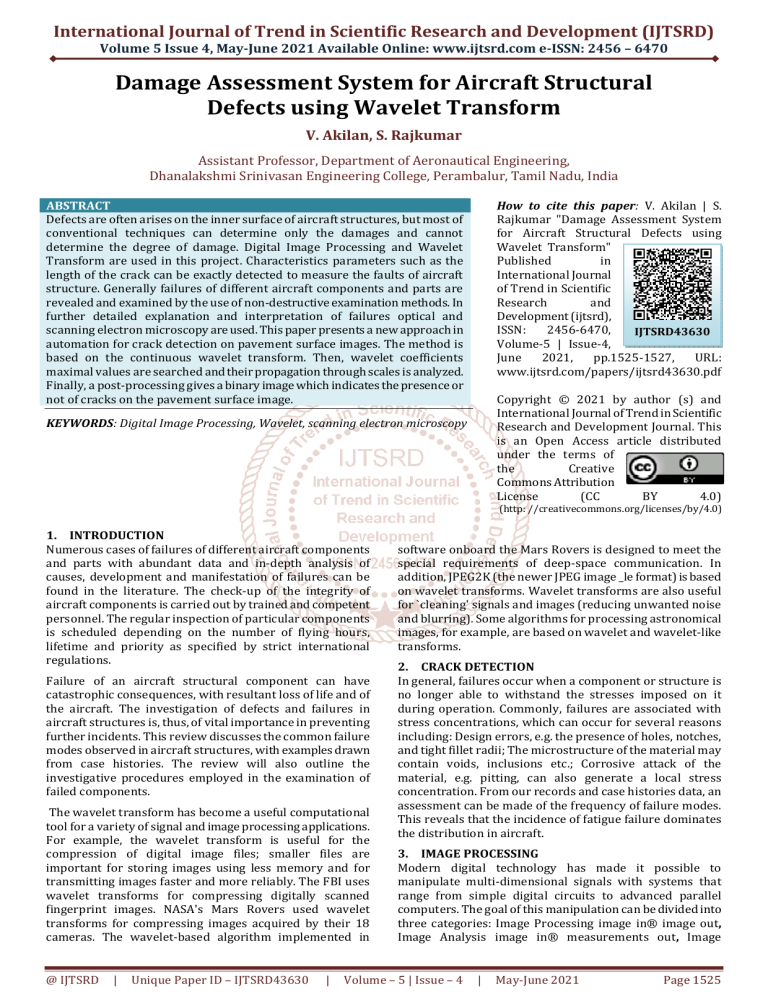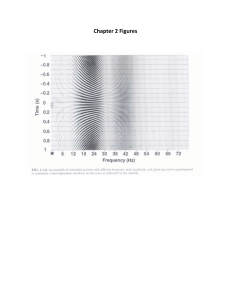Uploaded by
mail
Aircraft Defect Assessment via Wavelet Transform

International Journal of Trend in Scientific Research and Development (IJTSRD)
Volume 5 Issue 4, May-June 2021 Available Online: www.ijtsrd.com e-ISSN: 2456 – 6470
Damage Assessment System for Aircraft Structural
Defects using Wavelet Transform
V. Akilan, S. Rajkumar
Assistant Professor, Department of Aeronautical Engineering,
Dhanalakshmi Srinivasan Engineering College, Perambalur, Tamil Nadu, India
How to cite this paper: V. Akilan | S.
Rajkumar "Damage Assessment System
for Aircraft Structural Defects using
Wavelet Transform"
Published
in
International Journal
of Trend in Scientific
Research
and
Development (ijtsrd),
ISSN:
2456-6470,
IJTSRD43630
Volume-5 | Issue-4,
June
2021,
pp.1525-1527,
URL:
www.ijtsrd.com/papers/ijtsrd43630.pdf
ABSTRACT
Defects are often arises on the inner surface of aircraft structures, but most of
conventional techniques can determine only the damages and cannot
determine the degree of damage. Digital Image Processing and Wavelet
Transform are used in this project. Characteristics parameters such as the
length of the crack can be exactly detected to measure the faults of aircraft
structure. Generally failures of different aircraft components and parts are
revealed and examined by the use of non-destructive examination methods. In
further detailed explanation and interpretation of failures optical and
scanning electron microscopy are used. This paper presents a new approach in
automation for crack detection on pavement surface images. The method is
based on the continuous wavelet transform. Then, wavelet coefficients
maximal values are searched and their propagation through scales is analyzed.
Finally, a post-processing gives a binary image which indicates the presence or
not of cracks on the pavement surface image.
Copyright © 2021 by author (s) and
International Journal of Trend in Scientific
Research and Development Journal. This
is an Open Access article distributed
under the terms of
the
Creative
Commons Attribution
License
(CC
BY
4.0)
KEYWORDS: Digital Image Processing, Wavelet, scanning electron microscopy
(http: //creativecommons.org/licenses/by/4.0)
1. INTRODUCTION
Numerous cases of failures of different aircraft components
and parts with abundant data and in-depth analysis of
causes, development and manifestation of failures can be
found in the literature. The check-up of the integrity of
aircraft components is carried out by trained and competent
personnel. The regular inspection of particular components
is scheduled depending on the number of flying hours,
lifetime and priority as specified by strict international
regulations.
Failure of an aircraft structural component can have
catastrophic consequences, with resultant loss of life and of
the aircraft. The investigation of defects and failures in
aircraft structures is, thus, of vital importance in preventing
further incidents. This review discusses the common failure
modes observed in aircraft structures, with examples drawn
from case histories. The review will also outline the
investigative procedures employed in the examination of
failed components.
The wavelet transform has become a useful computational
tool for a variety of signal and image processing applications.
For example, the wavelet transform is useful for the
compression of digital image files; smaller files are
important for storing images using less memory and for
transmitting images faster and more reliably. The FBI uses
wavelet transforms for compressing digitally scanned
fingerprint images. NASA's Mars Rovers used wavelet
transforms for compressing images acquired by their 18
cameras. The wavelet-based algorithm implemented in
@ IJTSRD
|
Unique Paper ID – IJTSRD43630
|
software onboard the Mars Rovers is designed to meet the
special requirements of deep-space communication. In
addition, JPEG2K (the newer JPEG image _le format) is based
on wavelet transforms. Wavelet transforms are also useful
for `cleaning' signals and images (reducing unwanted noise
and blurring). Some algorithms for processing astronomical
images, for example, are based on wavelet and wavelet-like
transforms.
2. CRACK DETECTION
In general, failures occur when a component or structure is
no longer able to withstand the stresses imposed on it
during operation. Commonly, failures are associated with
stress concentrations, which can occur for several reasons
including: Design errors, e.g. the presence of holes, notches,
and tight fillet radii; The microstructure of the material may
contain voids, inclusions etc.; Corrosive attack of the
material, e.g. pitting, can also generate a local stress
concentration. From our records and case histories data, an
assessment can be made of the frequency of failure modes.
This reveals that the incidence of fatigue failure dominates
the distribution in aircraft.
3. IMAGE PROCESSING
Modern digital technology has made it possible to
manipulate multi-dimensional signals with systems that
range from simple digital circuits to advanced parallel
computers. The goal of this manipulation can be divided into
three categories: Image Processing image in® image out,
Image Analysis image in® measurements out, Image
Volume – 5 | Issue – 4
|
May-June 2021
Page 1525
International Journal of Trend in Scientific Research and Development (IJTSRD) @ www.ijtsrd.com eISSN: 2456-6470
Understanding image in® high-level description out. We will
focus on the fundamental concepts of image processing.
Space does not permit us to make more than a few
introductory remarks about image analysis. Image
understanding requires an approach that differs
fundamentally from the theme of this book. Further, we will
restrict ourselves to two–dimensional (2D) image processing
although most of the concepts and techniques that are to be
described can be extended easily to three or more
dimensions. We begin with certain basic definitions. An
image defined in the “real world” is considered to be a
function of two real variables, for example, a(x,y) with a as
the amplitude (e.g. brightness) of the image at the real
coordinate position (x,y). An image may be considered to
contain sub-images sometimes referred to as regions–of–
interest, ROIs, or simply regions. This concept reflects the
fact that images frequently contain collections of objects
each of which can be the basis for a region.
3.1. COMMON VALUES
There are standard values for the various parameters
encountered in digital image processing. These values can be
caused by video standards, by algorithmic requirements, or
by the desire to keep digital circuitry simple. Table 1 gives
some commonly encountered values. Quite frequently we
see cases of M=N=2K where {K = 8,9,10}. This can be
motivated by digital circuitry or by the use of certain
algorithms such as the (fast) Fourier transform.
Parameter
Symbol
Typical values
Rows
N
256,512,525,625,1024,1035
Columns
M
256,512,768,1024,1320
Gray
L
2,64,256,1024,4096,16384
Figure 1.4 Different basis for the transforms. (a) Real
part of the basis for Fourier transform, exp(j_t). (b)
Basis for different frequency, exp(j4_t). (c) Basis for
STFT, using Gaussian window of _ = 1. It is exp(t2=2)
exp(j_t). (d) Basis for different frequency, exp(t2=2)
exp(j4_t). (e) Mexican-hat mother wavelet function
and (f) s = 4
4. PROCESS
4.1. Captured image:
Table 1.1: Common values of digital image parameters
The number of distinct gray levels is usually a power of 2,
that is, L=2B where B is the number of bits in the binary
representation of the brightness levels. When B>1 we speak
of a gray-level image; when B=1 we speak of a binary image.
In a binary image there are just two gray levels which can be
referred to, for example, as “black” and “white” or “0” and
“1”.
3.1.1.
4.2.
Grayscale image:
4.3.
Binary image:
WAVELET TRANSFORM
Figure 1.3 A comparative preproduction of original
signals. The red line is the original signal. The blue
dash line is the approximated signal with (a)K = 0 (b)
K = 1 (c) K = 2 (d) K = 3 (e) K = 4 (f) K = 5
@ IJTSRD
|
Unique Paper ID – IJTSRD43630
|
5. Conclusion:
We have also tried to comparative discussion of Fourier
transform and wavelet transform mentioning the drawback
of Fourier transform, besides this we have discussed the
advantages of wavelet transform. A new family of filters has
been derived from the wavelet theory.
Volume – 5 | Issue – 4
|
May-June 2021
Page 1526
International Journal of Trend in Scientific Research and Development (IJTSRD) @ www.ijtsrd.com eISSN: 2456-6470
Novel methods based on rotational self-nulling probes and
linearly scanned probes were developed. Tests were
performed on both in-house manufactured specimens
(containing slots machined around holes) and samples
provided by leading airplane manufacturers.
By wavelet Analysis results in a non stationary signal and for
much clear processing. Very efficient to use this process and
get a high clarity and accurate degree of defect. This method
is software based, so less time is required and compare to
the NDT and other methods.
REFERENCES
[1] Rummel W. D. et al-“The detection of Fatigue Cracks
by Non-Destructive Testing Methods” NASA
contractor Report CR-2369, Feb. 1974.
[2]
Goransen U. – “Elements of Damage Tolerance
Verification”. Paper presented at 1983 ICAF Meeting,
Toulouse.
[3]
Daubechies. I. “The wavelet transforms timefrequency localization and signal analysis”. IEEE
@ IJTSRD
|
Unique Paper ID – IJTSRD43630
|
Transformation and Information Theory 36: 961- 1005,
1990.
[4]
Daubechics. I. “Ten Lectures on Wavelets”. SIAM,
Philadelphia, PA, 1992.
[5]
Daubechies. I. “Ten Lectures On Wavelets”. SIAM,
1992.
[6]
A. Cohen I. Daubechies J.-C. “Feauveau. Biorthogonal
bases of compactly supported wavelets”.
Communications on Pure and Appl. Math., 45(5):485–
560, June 1992.
[7]
Burrus. C. S, Gopinath. R. A, and Guo. H. “Introduction
to Wavelets and Wavelet Transforms”. Prentice Hall,
1997.
[8]
Mallat. S. “A Wavelet Tour of Signal Processing”.
Academic Press, 1998.
[9]
Bajaba. N. S, Ainefaie. K. A.“Multiple damage detection
in structure using wavelet transforms”. Academic
Press, 1998.
Volume – 5 | Issue – 4
|
May-June 2021
Page 1527


